SEO is a competitive field where anyone in the world could be your next challenger. Half the battle is knowing what your competition is doing now and what they plan to do in the future. These SEO comparison tools give you the scouting reports you need to identify these challengers, size them up, and ultimately outcompete them for the traffic your site deserves.
The best tools let you compare elements of your site, too. Knowing your own site's objective challenges and strengths can help you create the right strategies to grow your business.
When you compare your website to competitors and also compare your own site's rankings over time, you can see which practices work best for you and move away from the ones that don't offer much. The point is to develop a positive growth cycle.
Take a look at what you can do.
What Can I Compare with SpyFu?
These paths read like they're similar, but they actually take you to very different insights. The tools inside SpyFu let you compare competitor websites to your own and compare search terms that you want to research. Use any of these options to support your search marketing strategy:
| In Order To... | Use this tool… |
|---|---|
| Compare your ranks to a competitor | SEO Keywords |
| Compare a site's ranks to any point in time | Ranking History |
| Compare multiple sites' rankings for a specific keyword | Keyword Ranking History |
| Compare multiple sites' full keyword lists in SEO or PPC | Kombat |
| Compare your site to competitors' overall SEO or PPC performance | Competitors |
| Compare Search terms and their metrics | Related Keywords Tool |
| Compare ad copy from different competitors on the same keyword | Advertiser History |
| Compare ad copy changes from one competitor on the same keyword |
Ad History |
| Compare your page to competitors to make smarter updates |
RivalFlow AI (standalone) |
Compare your ranks to a competitor
We suggest you try: SEO Keywords
Competitor research is at the heart of the SpyFu tool, and this feature places your ranks on the page right alongside your competitor's ranks on the same keywords. It gives you valuable context and makes it easy to prioritize work when you see exactly how much they are outranking you on important search terms.

Compare a site's ranks to any point in time
We suggest you try: Ranking History
You have the opportunity to compare rankings from two different points in time. It can help you diagnose a drop in your ranks or, when you compare a competitor's domain, you can gut check the strength of a piece of their content.
Compare multiple sites' rankings for a specific keyword
We suggest you try: Keyword Ranking History
By searching competitors that all ranked for "gap insurance," you can tell which sites have been more dominant with their SEO performance, far more than what a single snapshot would show you. By comparing other domains on the same chart, you can look for any volatility on that specific SERP or topic.
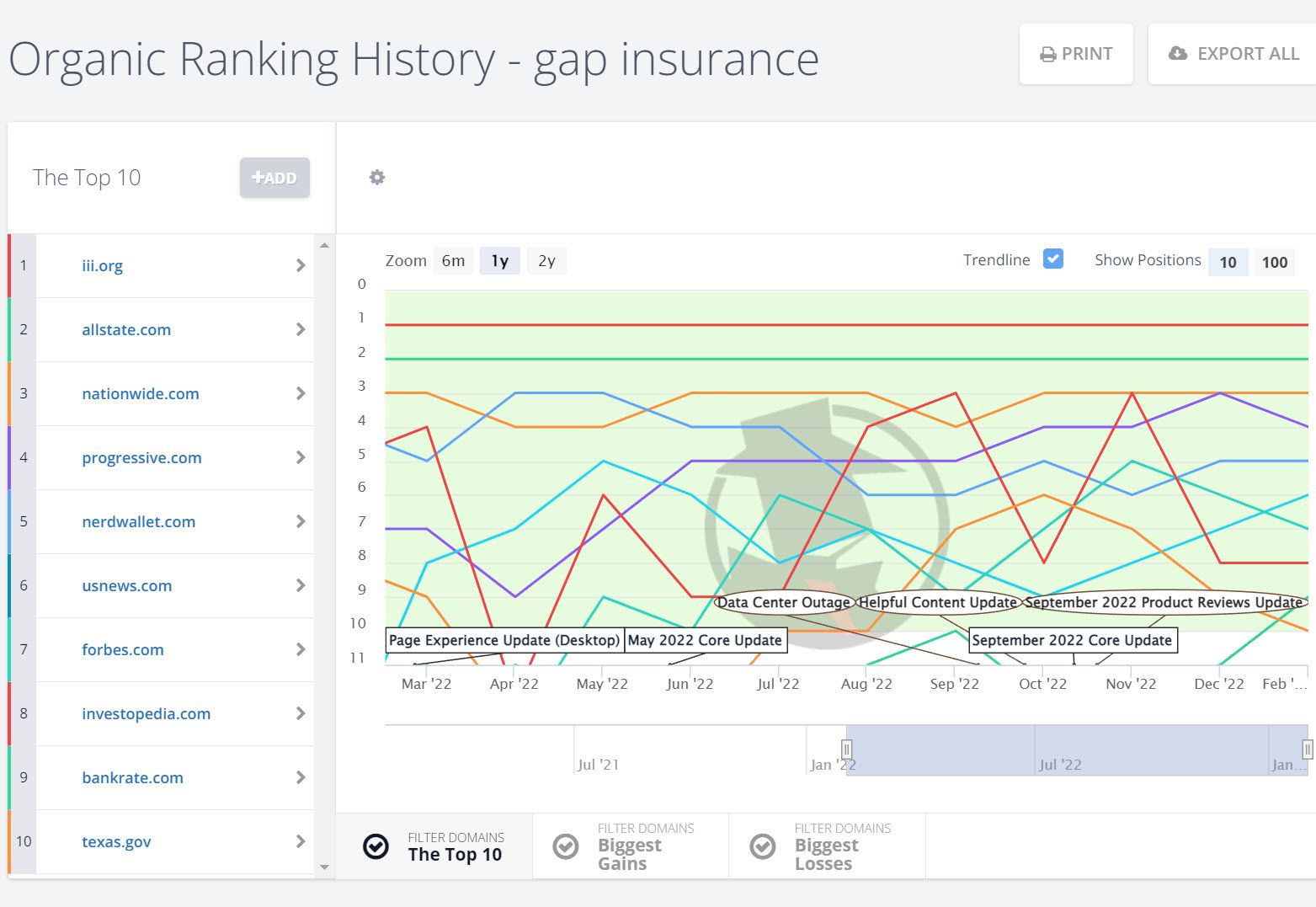
Compare multiple sites' full organic or paid keyword lists
We suggest you try: SEO Kombat or PPC Kombat
This multi-purpose feature is a popular tool to find keywords that your competitors rank for, but you don't. When you see the keywords that multiple competitors all rank for (or buy), it helps you see the most competitive, must-have topics in the industry.

Compare your site to competitors' overall SEO or PPC performance
We suggest you try: SEO Competitors or PPC Competitors
This helps you discover competitors you might not have considered for your business. Whether you plug in known competitors or emerging competition, you can compare their overall performance in a window of time to find your biggest threats and catch movement in your market.

Compare search terms and their metrics
We suggest you try: Keyword Overview and Related Keywords
If you have a single keyword to start with, like "piano lessons," the tools find similar keywords and list them alongside their metrics so you can compare the terms. The filters are key here in cutting down the list to the right set for your budget and your needs.
Use the Keyword Overview for an at-a-glance comparison of search terms, and then drill into the Related Keywords tool to compare them with their metrics on the page.

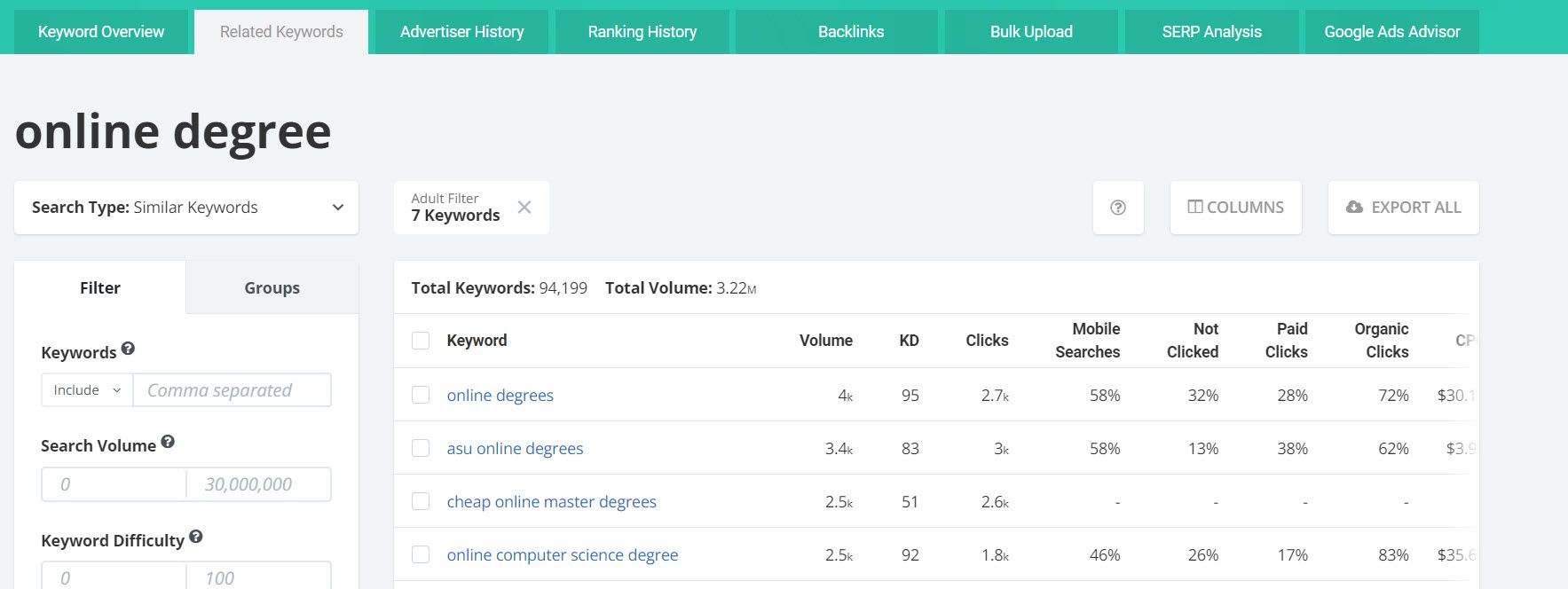
Compare ad copy from different competitors on the same keyword
We suggest you try: Advertiser History
This grid blends many answers in an elegant way. Your keyword search shows you which ads ran on it during the past year (and more), with a visual aid about consistent advertisers vs those that popped up from time to time. Not only are you comparing the advertisers' frequency and average ad positions, but you can also click through to compare the different ad copy they use.
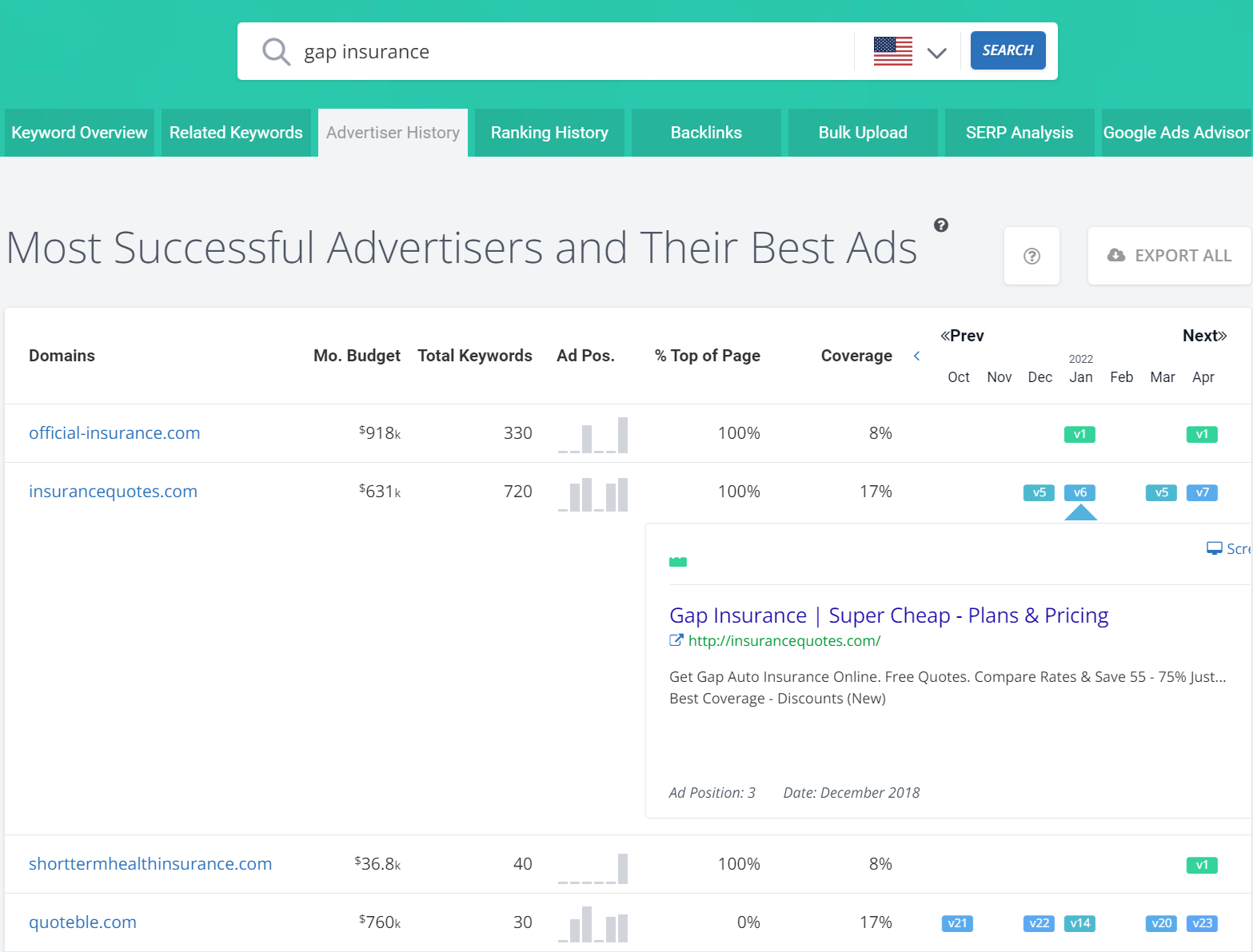
Compare Ad copy changes from the same competitor on the same keyword
We suggest you try: Ad History (for a domain)
This feature shows you an advertiser's full PPC keyword list, listed with every ad they ran for each keyword, in every month that the ad appeared. In one example, you can find the ad copy that Staples ran on its printer-related keywords. Compare the copy from the "brother all in one printers" to the ad copy they used for "hp all in one printers." Or, just focus on one keyword from that advertiser like "staples shipping boxes" and compare their ad copy changes from October to November.
This helps you to find an advertiser's most dominant message and see what they learned from their ad copy updates.

More Options to Compare Your Competitors
SEO comparison tools are the best way to understand your competitors’ SEO strategies because they easily dissect real-time data and show you how strong your opponent is, where they are having organic success, and which areas they’ve yet to exploit.
The tools inside SpyFu let you dig into your competitors' results. By learning how to use these tools, you’ll understand the thinking behind competitor strategies, from the individual keywords and backlinks they are targeting to the clusters they are building—and with this information, you can create a content plan designed to lift your site in the SERPs and drive traffic to it.
1. Identify Your Competition
Before you can beat them, you need to know who your competitors are. You also need to know which competitors are the most important to target based on how much overlap your businesses have and how likely it is for you to outcompete them right now.
Generally speaking, competitors can be:
- Direct Competitors: Websites or businesses that have the same business model as you.
- Organic Competitors: Websites or businesses targeting similar keyword clusters to you despite having different business models.
If you want to find success through content marketing, you will need to not only beat the businesses who have a competing product, but also the websites that are organically competing with you for rankings on search engine results pages (SERPs).
Where Can You Find Your Competitors?
The two best places to find your direct and organic competitors are on Google and with a competitor analysis tool.
Using a search engine like Google is a great place to find direct and organic competitors. Simply plug in your primary keywords and scroll through the results. For example, if you sell environmentally friendly tumblers, put that into Google and see who else is on that top 10.

All three listings above are organic competitors. However, they also represent an opportunity to reach out and collaborate. Could you email Mashable and add your tumbler to their list? Could you beef up your Amazon listing so that you beat out one of your direct competitors, Choary, for this particular page?
As you explore different SERPs, take note of the organic and direct competitors that continually pop up. These are the websites that you’ll want to do a deep dive into so you can plan to not only beat them on one SERP but across multiple keywords and topic clusters.
The downside is that this snapshot is one moment in time. Google frequently updates its search results, and what you see now won't necessarily be there the next time you look. Or take it from another angle. You rank for many similar keywords that relate to the same products, but the phrasing depends on how a searcher asks. That's why we recommend a third party SEO tool like SpyFu.
Input your web domain (or one of your top competitors if your website is new), and the algorithm will find the websites that are competing with you for keywords.
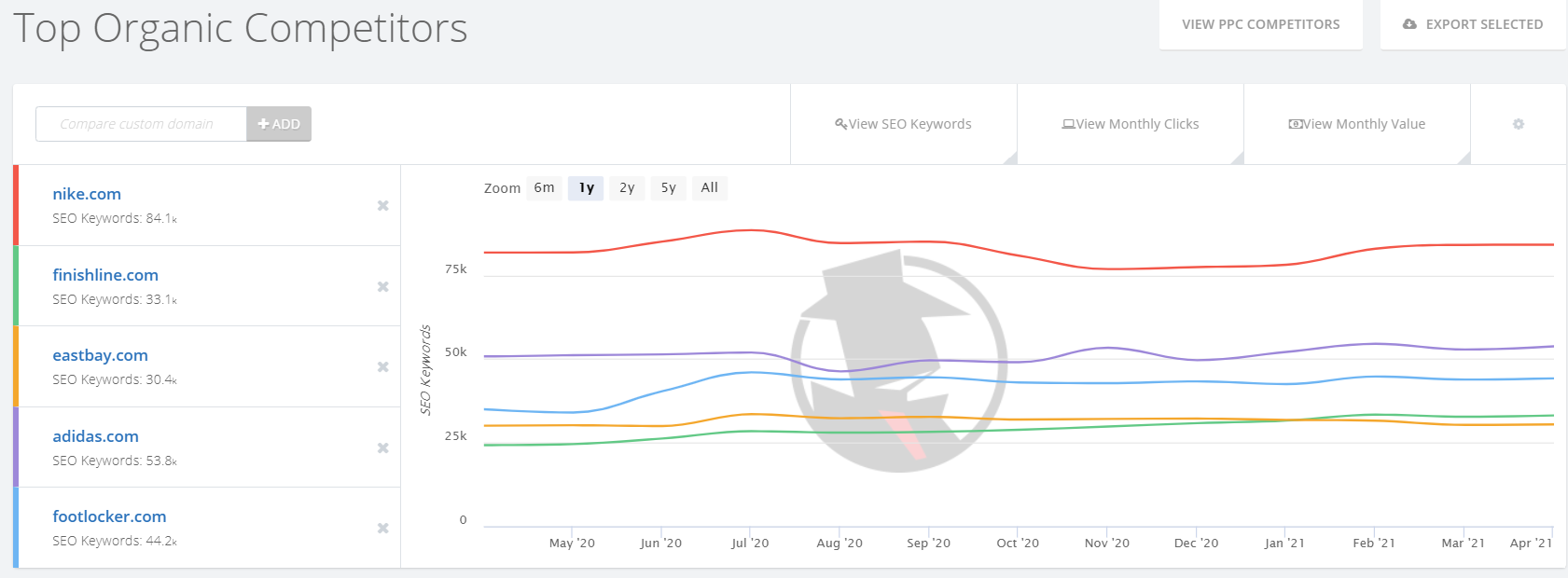
With this graph, you can easily see who your competitors are and how you stack up against each other in terms of overall keyword numbers. The advantage to this method is that, for larger websites, it can be difficult to fully grasp their keyword strength solely by poking around random SERPs.
Between checking the SERPs and using a competitor tool, you should get a good list of potential competitors you may want to focus on with your content and SEO strategy. From this list, you can start making decisions on who you want to research further.
How Can You Pick the Right Competitors to Target?
You can’t actively compete with everyone in your sphere. It is better to find two or three main competitors you want to focus on over the medium term so that you don’t put too much research or content on your plate at once.
When considering who you want to compete with, think about:
- How much is their business or organic traffic worth to you?
- How likely is it that you can take a meaningful chunk of their traffic?
Compete with businesses whose traffic and resulting conversions are worth the time and resources you spend on crafting and executing a content marketing strategy. Also, be realistic. If you are a new e-commerce platform, you won’t be beating Amazon next year, but go after some smaller fish now, and maybe the big ones won’t look so big five or ten years down the line.
Finding snapshots of the relative SEO strength of a website is nearly impossible without some form of SEO tool. For instance, SpyFu’s SEO Overview tool will tell you roughly how many keywords the website ranks for, how much traffic it is getting, how much that traffic is worth, and how their clicks and traffic numbers have been trending over the last year.
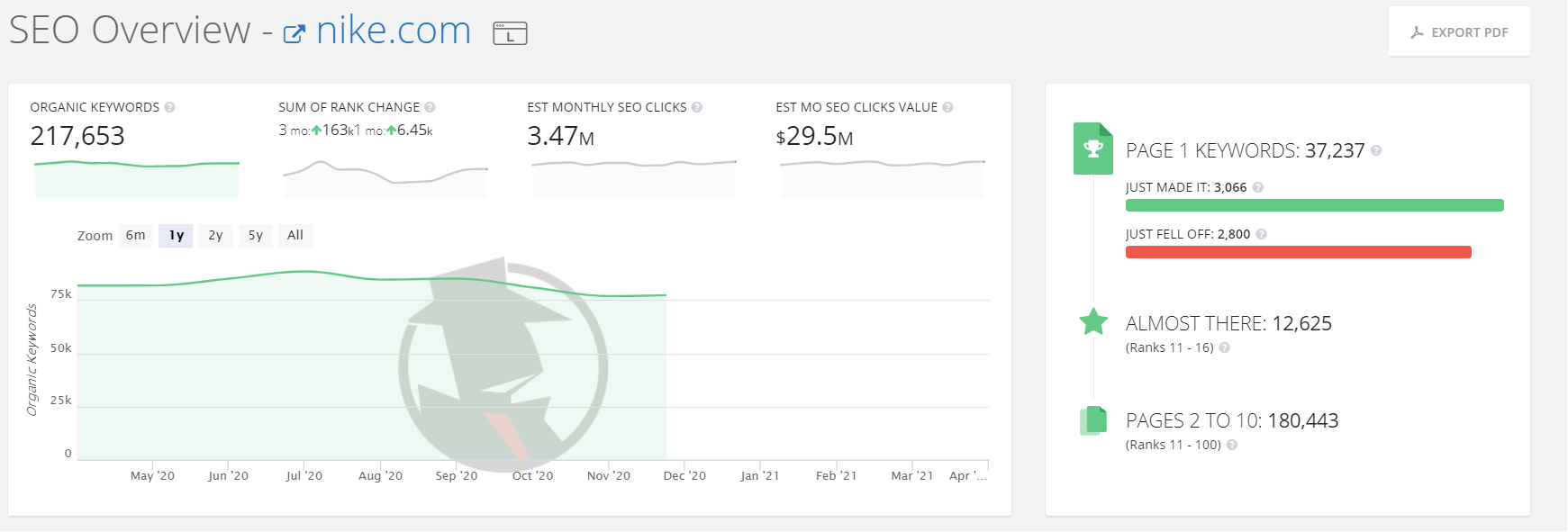
Go through the data on this page and take ten minutes to explore their website. Ideally, when starting out, you’ll want to find websites that get a similar amount of traffic to your own. You can then target the areas they excel in to steal their keywords and traffic and grow your brand. However, sometimes you’ll be forced to contend with bigger fish than you. When faced with far bigger competitors, you’ll need to pick your battles wisely, zeroing in on one or two topic clusters where you can outhustle the established presences in your field.
2. Research Competitors’ Top Pages and Topics
Websites are usually built around a small collection of top pages, keywords, and clusters. Now that you know who your competitors are, you’ll want to see which of their pages, keywords, and topic clusters are the ones you want to put effort into stealing for yourself. When you are done with this research, you should be left with the foundations of your new content marketing plan. Specifically, you’ll have a list of your competitors’ SEO assets that are the most valuable to your business, with some idea of their weaknesses so that you can beat them later with your content.
How Do You Find and Analyze a Competitor’s Top Pages and Keywords?
Chances are that a competitor’s most valuable keywords in terms of traffic and monetary value will be located on their top pages, so these two can be targeted at the same time. What you are looking for are the keywords and pages that you wish your business were ranking for.
Tools like SpyFu can estimate the SEO value of a keyword and put that into dollars. Some keywords are worth more than others; usually, keywords with buyer intent are worth more to companies than purely educational keywords, as buyer intent keywords are more likely to lead to conversions.
Start by using an SEO comparison tool to find the top pages of a competing website. We’ll use SpyFu as an example. When scanning the top pages, ignore the homepage and focus on blog or product pages you want to outrank. The best pages to target get lots of clicks and help build up one part of your business’s marketing funnel.
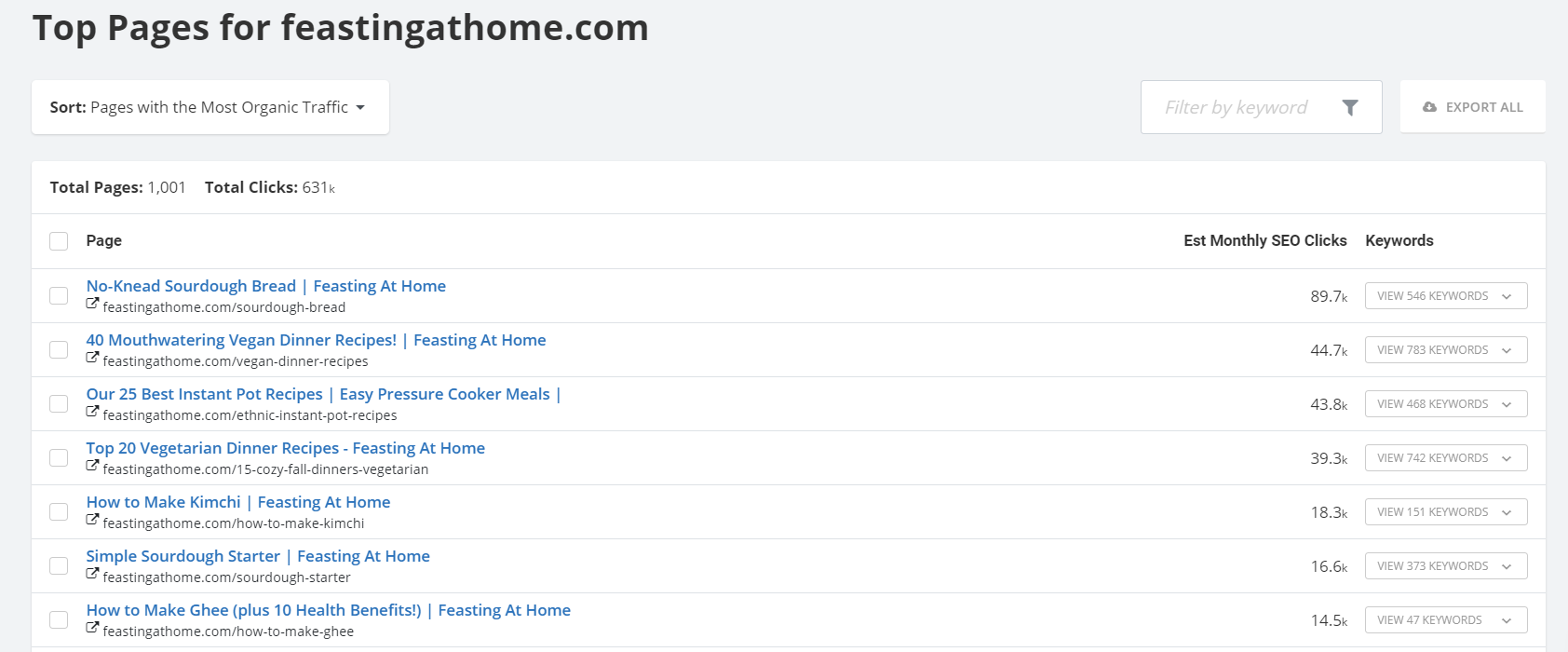
For example, if you were a cooking blog that sells cookbooks, you would want to find the top recipes that bring traffic to your competitor’s site. By looking up feastingathome.com’s top pages, we can see that the sourdough recipe page is bringing in nearly 90,000 SEO clicks a month.
However, traffic is not everything. You need to keep in mind relevancy. If you sell gluten-free cookbooks, then sourdough starter recipes won’t help you with your audience. Instead, you could explore the post about vegan dinner recipes as this would bring in traffic that is valuable to you, i.e., people who would be interested in buying your books.
When you find a page that you want to target, the next step is to drill down into which keywords are bringing them this traffic. You’ll want to know this so you can understand which keywords you could optimize your new page for. With SpyFu, you can save yourself some time and click the top keywords associated with each page.

As you work, make a list of the pages you are interested in with their associated top keywords. This list can be the start of your future content calendar and strategy.
With your pages and keywords listed, click each page and start to analyze it for weaknesses.
Consider:
- Is it outdated?
- Can you add new information or research?
- Can you take a unique or contrarian approach or opinion?
- Can you better serve user intent than the existing content?
Beating your competitor’s content is more than just rehashing what they’ve already done. Understand why these pages have been successful, and then write down how your new page will improve on it. If you’ve done it right, your new piece will add more value, draw more readers, and be rewarded in the SERP.
How to Beat Your Competitor’s Topic Clusters
After you’ve scoured your competitor’s websites for pages you want to beat, you’ll be left with a seemingly random list of potential content ideas. It’s now time to put those ideas into cohesive frameworks called topic clusters. Topic clusters are a collection of pages on a website that explore different subtopics in a larger parent topic. Growing topic clusters will boost your topical authority, a measure of how much Google believes you are an authority on this topic, which can help you boost your keyword rankings.
You will want to be a topical authority on the topic clusters important to your business. To start, get your own house in order. Do a content audit and determine which topic clusters you already have put time into. Next, slot in your new content ideas from your competitor’s top pages and keywords. Now, it’s time to see what we can learn from our competitor’s topic clusters.
Comparing competitors’ topic clusters can help you by:
- Showing you what topics exist in a particular cluster
- Giving you new content ideas to explore
- Previewing the potential clicks you can get from a particular cluster
Although you could explore a competitor’s topic clusters by poking around their website and manually mapping them one by one, it is often easier to use a keyword tool instead. This tool will group a competitor’s keywords by topic cluster and then list the root pages most of those keywords are coming from.
For example, with SpyFu, you can use the SEO Keywords tool to filter by topics. Then, you can explore the top keywords to see which pages are contributing the most to each cluster.
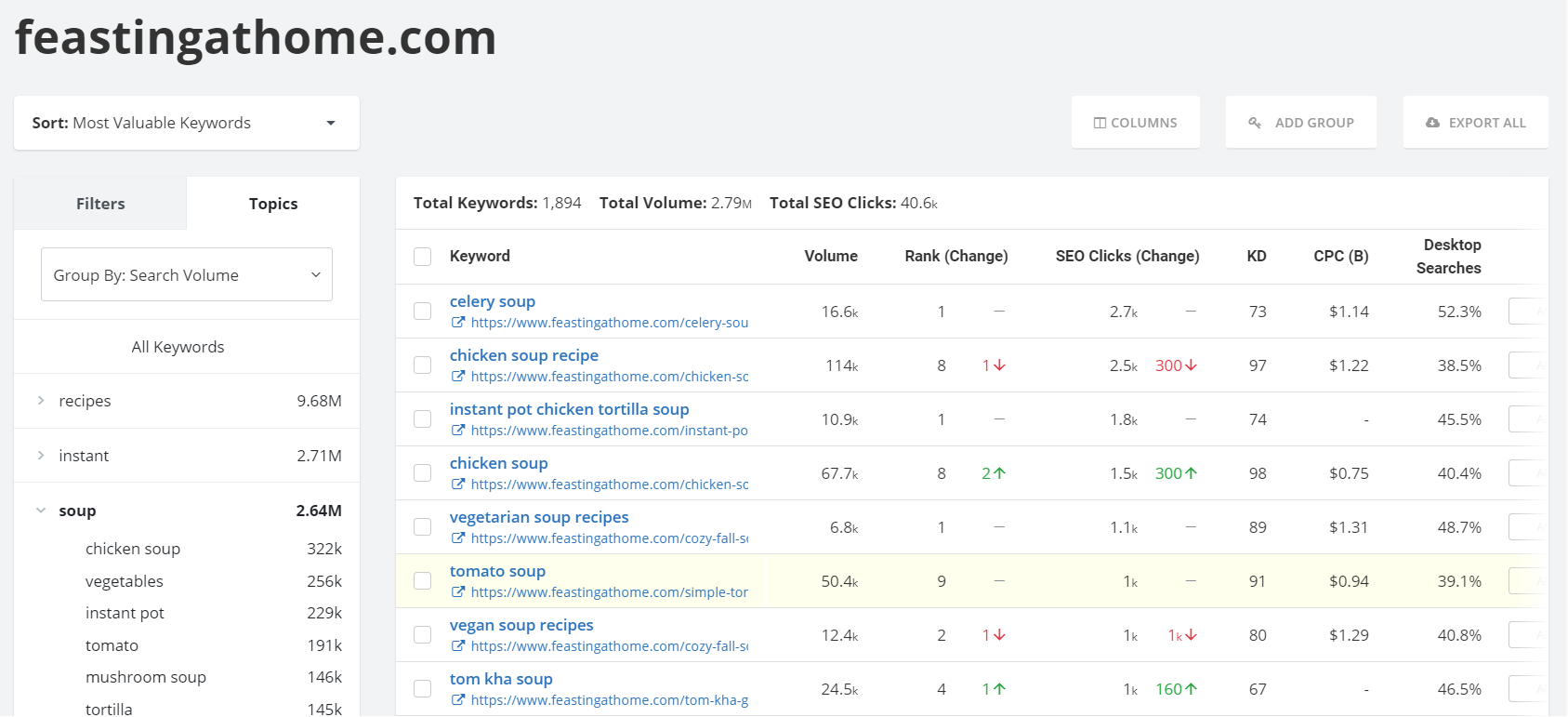
For instance, if you were putting together a topic cluster on soups, you could examine the top keywords about soup on your competitor’s page and then start making plans to write competing recipes for your own topic cluster.
With SpyFu, you can also see the number of estimated SEO clicks each topic cluster gets beside the cluster itself on the left sidebar. For instance, this soup cluster garners a total of 2.64 million hits. This data should help you determine how much effort you want to put into competing for this cluster.
Don’t forget to also consider which pages aren’t currently in the cluster. Are there recipes that are missing? You don’t always have to compete head-to-head. Although you’ll want to eventually rank highly for these most valuable keywords, you should also plan to hit some softer targets as well.
3. Find Easy Keyword Opportunities
No matter how prolific you are, there are always topics that you will forget to write about. When planning your future content clusters, you will want to find these gaps so you can plug them with new content to bolster your topical authority.
Using SEO comparison tools, you can easily find these content gaps on both your website and on your primary competitors’ websites. With these ideas in hand, you can crank out articles designed to collect the keywords you need to attract new readers.
How Can You Find Content Gaps?
Content gaps exist when no page has been made on your website (or perhaps any other) that answers the questions or fulfills searchers' intents. Generally, these gaps are for long tail keywords, keywords that use several words that have a more focused intent but with lower volume numbers than short tail keywords.
One way to find content gaps is to keep an eye on the community you are servicing by being an active participant in forums or social media websites. Use websites like Reddit to see what people are talking about. For instance, in the subreddit “r/workfromhome,” one user asks what home office equipment should he buy with a budget of $250.
This question could form the basis of your next great article. Do a quick Google search to double-check whether there is anything meeting this demand, and then use a keyword tool to find a good keyword to optimize for and set this idea to the side for future writing.
Finding ideas organically through interactions with your community is always important, but sometimes you don’t want to troll through a number of sites and posts before you strike gold. In this case, you can use keyword comparison tools to see which keywords your competitors are ranking for, but you’ve so far neglected.
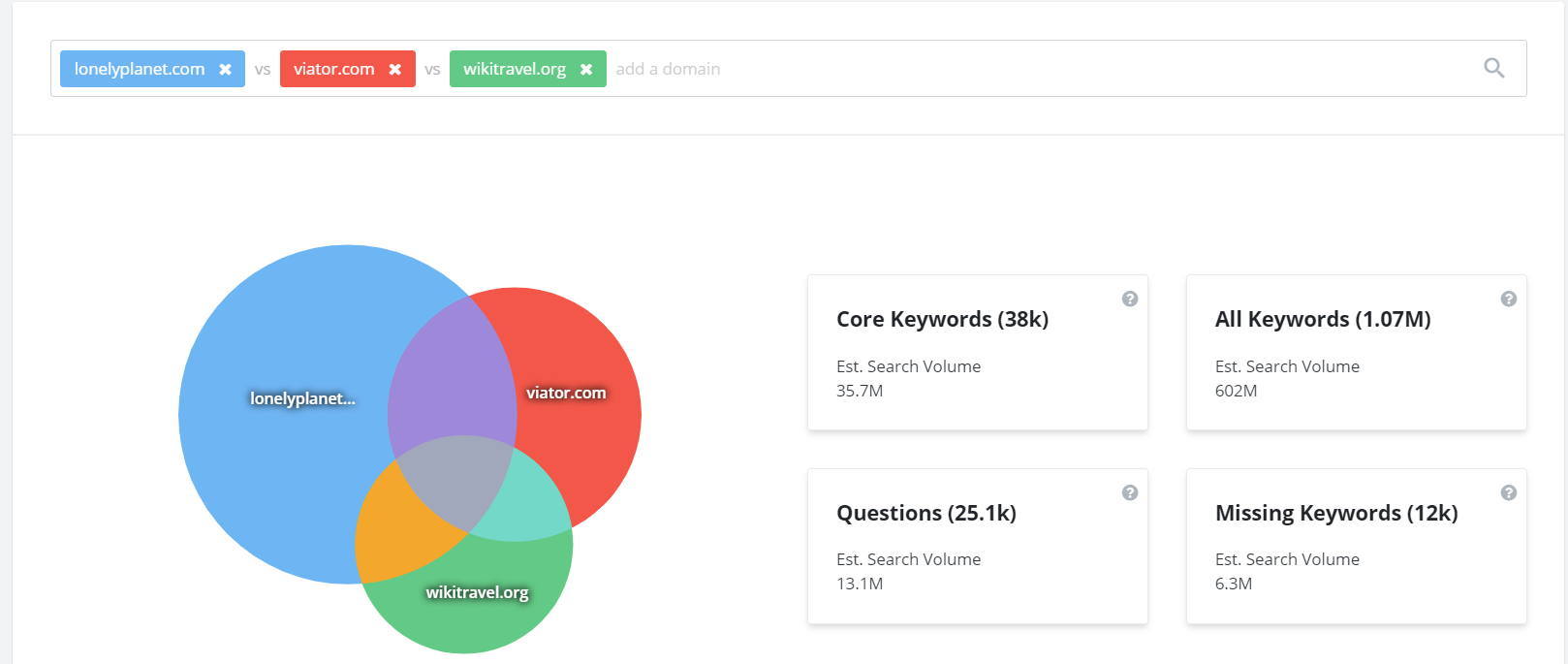
With Kombat on SpyFu, you’ll be able to see which keywords you share with competitors, and importantly, which keywords you are missing.
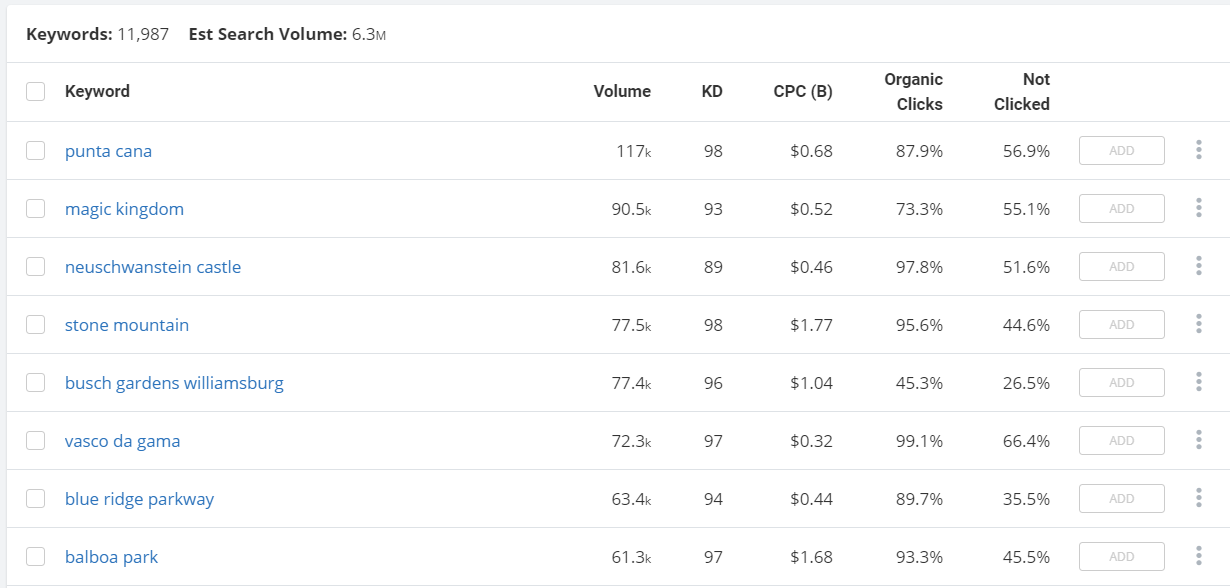
You can also use this feature to find content gaps that exist in your competitors’ topical clusters. If you only compare your future topic cluster to one or two others, you may miss out on any topics they themselves have forgotten.
The best way to avoid this is to add several competitors (organic and direct) to Kombat and compare those competitors to one of your primary competitors. Then, search through their missed keywords so you can capitalize where your competitor has missed out.
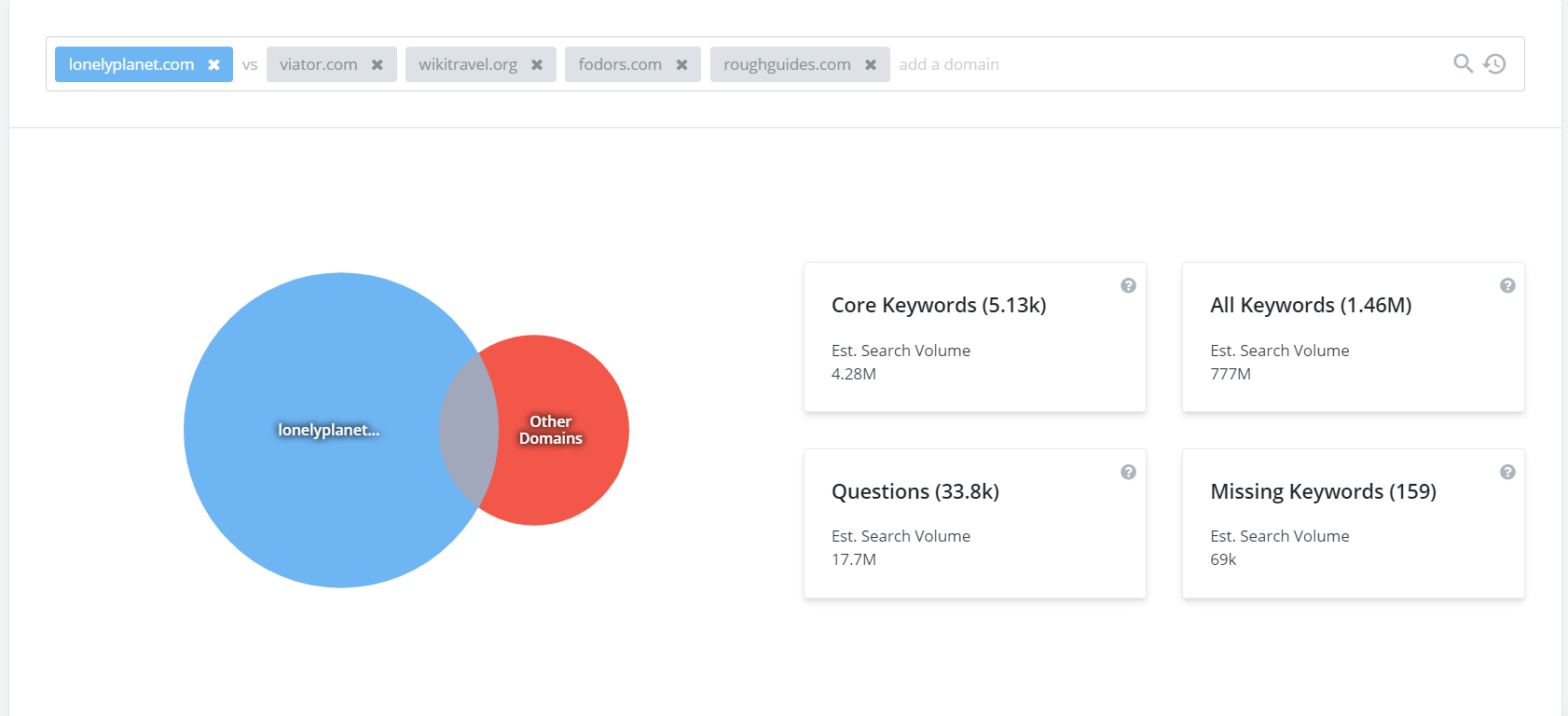
Each of the keywords you find during your content gap research could be spun into its own piece of content that could improve your topical authority and add new keywords to your website. And, when written well, you have the added benefit of stealing traffic from your competitors.
4. Target Competitor Backlinks
Backlinks are hyperlinks that take readers from other websites to yours, and they help tell Google which web pages are the most useful and authoritative. They can often be the difference between a well-written, well-researched article that languishes on the second page of Google and an equally great piece perched in the top spot.
Use a backlink tool to find backlinks valuable to the keyword you are targeting or find the websites linked to your competitors but not you. With a constant effort, you can build up your backlink profile, helping you win the individual keyword battles necessary to overcome the pages and topic clusters built up by your competitors.
How Do You Use a Backlink Tool?
Backlink tools are best used to cut out the time-consuming task of searching the internet for broken or ill-fitted backlinks on competitor websites. Backlink tools skim the internet for opportunities, so you just have to focus on reaching out to prospective websites and convincing them to add your link to their site.
Just type in a domain or URL, and you’ll be left with a complete list of all of the links to that page.
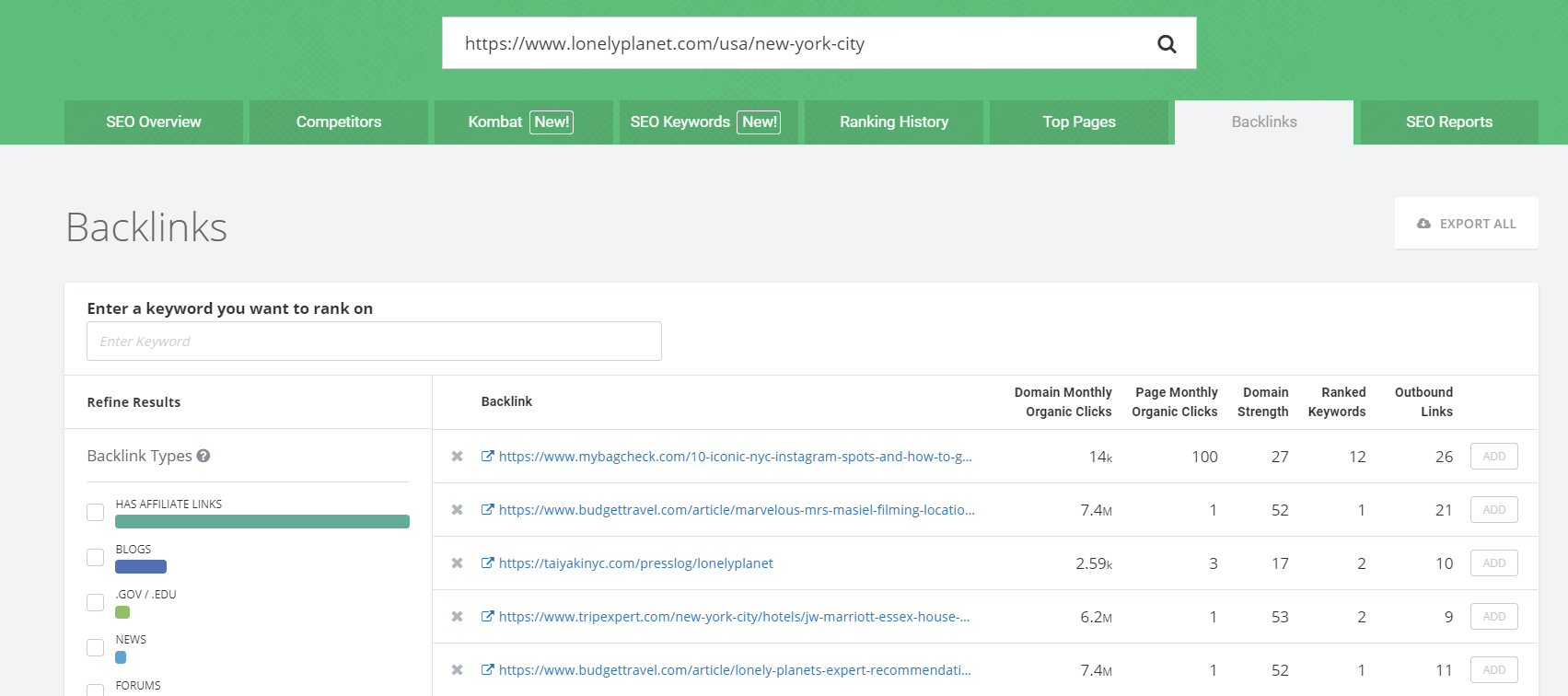
If you are writing a competing page or article, your competitor’s backlinks are the first place to reach out to as you would ideally want to replace a link to their website with a link to yours.
With SpyFu’s backlink tool, you can also search for backlink opportunities by specific keywords. The advantage of this tactic is that it can be annoying to look up the backlinks on each page on a website. This way, you can search by a competitor's domain and then filter by the keyword you are optimizing for.
Simply add a keyword in the search bar, and you’ll get a list of potential backlink opportunities for you to explore. You can also filter by backlink type if you are interested only in backlinks from forums, .gov websites, etc.
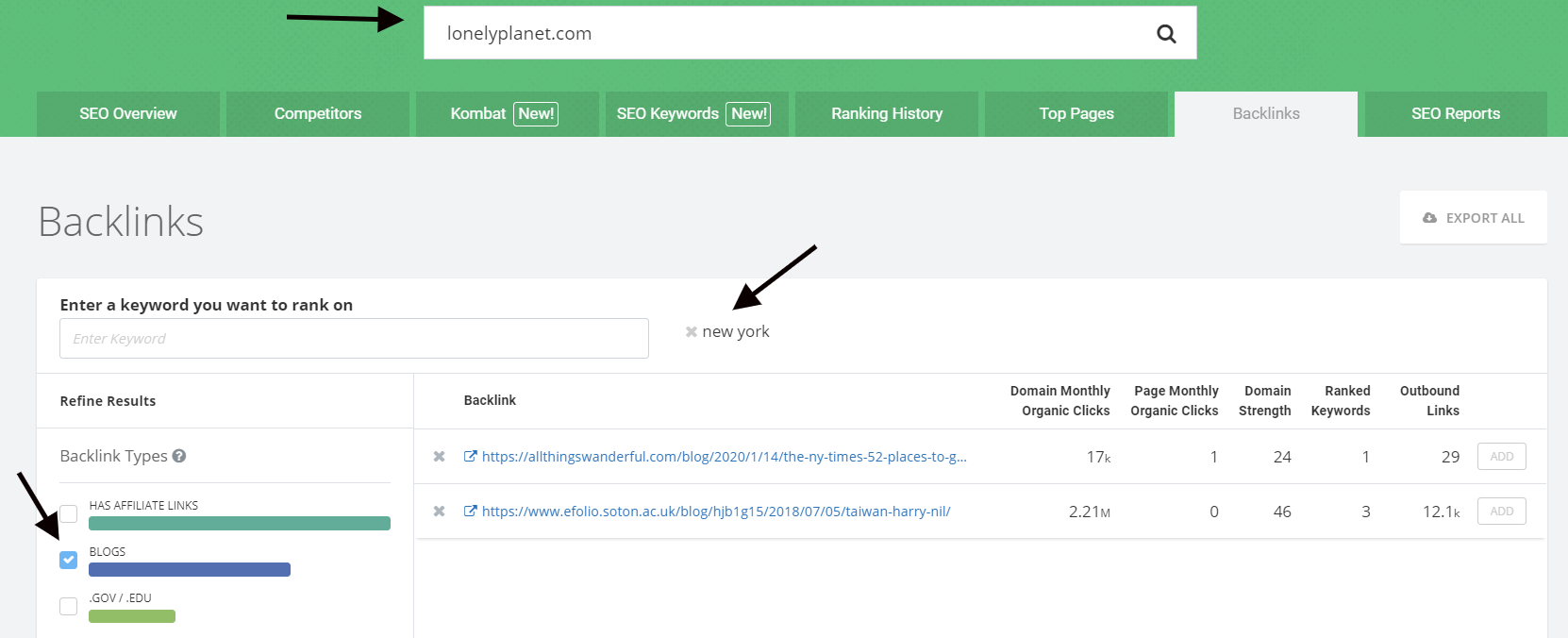
Backlink building is one of the most frustrating parts of SEO as it takes time and a lot of failures to get it right. Take a look at our guide to finding new backlink opportunities to learn more about mastering this essential SEO skill.
5. Understand a Competitor’s Current Content Strategy
Your competitors are not static targets. They are constantly evolving and trying to outdo each other. Knowing where your competitors are putting their content marketing efforts can allow you to plan and counter their strategies.
How Can You Keep Up to Date on Their Content?
Keeping up to date with your competitor’s content is as easy as making a habit of reading their blog, signing up for their emails, and following them on social media sites. It doesn't require any fancy tools, just some time and critical thinking.
When consuming their content, think about:
- Who are they writing for?
- What value props are they emphasizing?
- What posts/pages are getting the most engagement online?
- Which topics, products, or features do they often write about or highlight?
If it helps, keep a notebook of observations so you can go back and look for larger macro trends that can help you piece together their SEO strategy.
How Can You Use This Information?
With your collected competitor research, you can identify and plan for their current content marketing strategies by spotting patterns, prioritizing trends that may affect your business, and mapping out potential counters.
Start by looking at the trends: What clusters are they building from scratch or working to enhance? If they are building a cluster that affects your bottom line, then you’ll want to dig deeper. Specifically, you‘ll want to know:
- Which new pages are getting traffic?
- What new keywords are they ranking for?
Use SEO tools to quickly gather this data. With SpyFu, you can find this through the Top Pages tool.
On the Top Pages tool, toggle it to show you the top new pages on a website so you can get a better idea of which new content is taking off.
On this page, look at the keywords each page is ranking for and how much monthly SEO traffic they are bringing in. If a page is taking off quickly, ask yourself why. Are they filling a gap in the market that has always existed, or is it simply a timely article that will peter out?
If it’s a timely topic you want to engage with, put creating a competing piece of content at the top of your content creation priorities.
If this is a piece that will likely see continual SEO traffic for some time and adds to a topic cluster that is competing for your traffic, then make this a long-term goal to outcompete. You can add creating a competing piece of content to your future plans.
Understanding the content goals of your competitors should also inform how you approach your SEO strategy. If your top competitor is boosting a topic cluster you are both competing for, it may be time to double down on it and push out more content to counter them.
On the other hand, if your competitors are focusing on clusters that aren’t directly related to your audience or product, then you should focus on chipping away at their topical authority in areas you are still trying to grow into.
Finally, don’t forget to play a little defense. Keep an eye on older pieces in your topic clusters at risk of becoming outdated or obsolete. You can line up a refresh to boost its rankings and stave off competitors trying to outdo your SEO strategies.
A refresh is part of the content improvement cycle. On that note...
Bonus: Compare My Page to Competitor Page That Outranks It
This one is listed separately because the tool is outside of SpyFu. However, RivalFlow's page comparison offers a key part of SEO – improving content to boost its rankings.
The ranking boost doesn't just come from the fact that you have refreshed a page. It relies on the page growing in depth and helpfulness--more details and more answers about what your readers want to know.
RivalFlow compares your best pages (one at a time) head to head against a higher-ranking competitor to find what's missing from your article. It might be a better example about an idea you shared, or maybe it's a couple of paragraphs answering a question about your topic that you hadn't considered. Adding those into your existing page can make Google see it in a new and improved light.
As you continue a practice of ongoing improvement, the benefits should spread across your entire site.
SEO Comparison Tools Make SEO Easier
SEO comparison tools give you everything you need to understand and overcome the competitors you will face on your way to dominating the SERP. From keywords to backlinks, you can see where your competitors are finding success and then design the content plans that’ll help you steal their traffic and market share.
However, the SERP is not just about organic rankings. If you want to completely control the top 10, you need to consider the PPC strategies of both yourself and your competitors. Learn more about how to run your PPC campaigns so when a potential customer searches the keywords you are targeting, it’ll be your product and website waiting to help them out.

